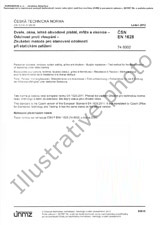We need your consent to use the individual data so that you can see information about your interests, among other things. Click "OK" to give your consent.
ČSN ETSI EN 302537-V2.1.1 (875140)
Ultra Low Power Medical Data Service (MEDS) Systems operating in the frequency range 401 MHz to 402 MHz and 405 MHz to 406 MHz; Harmonised Standard covering the essential requirements of article 3.2 of the Directive 2014/53/EU
Translate name
STANDARD published on 1.3.2017
The information about the standard:
Designation standards: ČSN ETSI EN 302537-V2.1.1
Classification mark: 875140
Catalog number: 501555
Publication date standards: 1.3.2017
SKU: NS-676739
The number of pages: 60
Approximate weight : 180 g (0.40 lbs)
Country: Czech technical standard
Category: Technical standards ČSN
The category - similar standards:
Annotation of standard text ČSN ETSI EN 302537-V2.1.1 (875140):
V2.1.1
The present document applies to ultra low power systems and accessories operating in spectrum within the bands 401 MHz to 402 MHz and 405 MHz to 406 MHz that operate in a MEDS service for telecommand and telemetry between devices that are part of a MEDS (see definition of MEDS);
1) Only two types of MEDS system devices are permitted under the present document:
- 2) Frequency agile devices designed to access a minimum of 18 channels evenly distributed across the 401 MHz to 402 MHz and 405 MHz to 406 MHz bands with a minimum of 9 channels for each 1 MHz segment (i.e. 401 MHz to 402 MHz and 405 MHz to 406 MHz).
Devices capable of operation only on a single channel using low duty cycle and low power for spectrum access in the 401 MHz to 402 MHz or 405 MHz to 406 MHz bands, see clause 4.2.3.1.2 and the following clauses.
The frequency usage conditions for the bands 401 MHz to 402 MHz and 405 MHz to 406 MHz are European wide harmonised for "active medical implant devices" according to Commission Implementing Decision 2013/752/EU [i.12] and ERC Decision (01)17 [i.1] with the following usage restrictions:
- " "This set of usage conditions is only available for systems specifically designed for the purpose of providing non-voice digital communications between active implantable medical devices and/or body-worn devices and other devices external to the human body used for transferring non-time critical individual patient-related physiological information."
The present document covers devices utilizing ultra low power radio devices in combination with medical devices, the medical portion of which is regulated by the Medical Device Directive [i.8] (MDD) or the Active Implantable Medical Device Directive (AIMD [i.9]). The radio part of medical devices regulated by the MDD is hereafter referred to as ULP-AMD, ULP-AMD-P for peripheral devices, and ULP-BWD for body worn devices. ULP-BWD are devices, such as a physiological parameter sensor or handheld devices that are intended to operate in very close proximity to the human body, including touching the body, whose radio antenna is external to the body and is used to communicate with a device that is part of a MEDS system. The radio part of medical devices regulated under the AIMD is hereafter referred to as Ultra Low Power-Active Medical Implants (ULP-AMI) and peripherals (ULP-AMI-P) used in a Medical Data Service (MEDS).
Devices covered by the present document are an evolving new technology to be made available worldwide by the medical equipment industry that will provide high speed communications capability between devices associated with an individual patient that are part of a complete MEDS system as defined in clause 3.1. Examples of MEDS devices falling under the scope of the present document are portable body worn physiological sensors that allow ambulatory monitoring, implanted devices and external system devices used to transfer data collected by a MEDS system to medical practitioners that will use the data to diagnose and treat a patient.
The present document contains requirements to demonstrate that Ultra Low Power Medical Data Service (MEDS) Systems operating in the frequency range 401 MHz to 402 MHz and 405 MHz to 406 MHz ". shall be so constructed that they both effectively use and support the efficient use of radio spectrum in order to avoid harmful interference" (article 3.2 of the Directive 2014/53/EU [i.2]). It does not necessarily include all the characteristics, which may be required by a user, nor does it necessarily represent the optimum performance achievable
Preview of the standard ČSN ETSI EN 302537-V2.1.1 (875140)
We recommend:
Technical standards updating
Do you want to make sure you use only the valid technical standards?
We can offer you a solution which will provide you a monthly overview concerning the updating of standards which you use.
Would you like to know more? Look at this page.




 Cookies
Cookies
